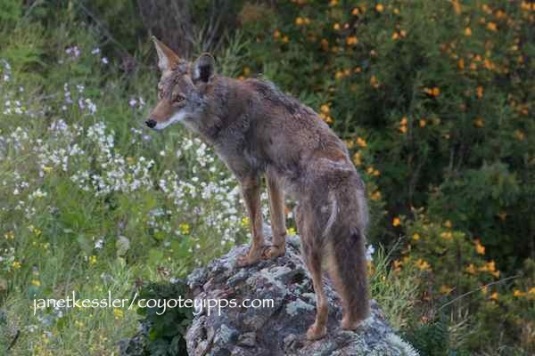 Malcolm Margolin’s book, The Ohlone Way, has a brief description of the setting in San Francisco, including the vast number of animals that inhabited the land, before the European settlers moved in, and the behavior of these animals towards humans. I am reprinting this excerpt, with permission, from pages 9 and 11 of his book. It goes a long way to explain the very natural behavior seen in this video between a bobcat and a coyote who are caught in their own very natural interaction with humans standing close by being ignored by the two animals. It is the ignoring of humans which is of prime interest in this posting, though the interaction between the bobcat and coyote is fascinating. I’ve seen the same kind of interaction between a skunk and a coyote: https://www.facebook.com/jon.snow.56481/videos/vb.25318743/10101407149702764/?type=2&theater.
Malcolm Margolin’s book, The Ohlone Way, has a brief description of the setting in San Francisco, including the vast number of animals that inhabited the land, before the European settlers moved in, and the behavior of these animals towards humans. I am reprinting this excerpt, with permission, from pages 9 and 11 of his book. It goes a long way to explain the very natural behavior seen in this video between a bobcat and a coyote who are caught in their own very natural interaction with humans standing close by being ignored by the two animals. It is the ignoring of humans which is of prime interest in this posting, though the interaction between the bobcat and coyote is fascinating. I’ve seen the same kind of interaction between a skunk and a coyote: https://www.facebook.com/jon.snow.56481/videos/vb.25318743/10101407149702764/?type=2&theater.
“The environment of the Bay Area has changed drastically in the last 200 years. Some of the birds and animals are no longer to be found here, and many others have vastly diminished in number. Even those that have survived have (surprisingly enough) altered their habits and characters. The animals of today do not behave the same way they did two centuries ago; for when the Europeans first arrived they found, much to their amazement, that the animals of the Bay Area were relatively unafraid of people.”
“Foxes, which are now very secretive, were virtually underfoot. Mountain lions and bobcats were prominent and visible. Sea otters, which now spend almost their entire lives in the water, were then readily captured on land. The coyote, according to one visitor, was “so daring and dexterous, that it makes no scruple of entering human habitation in the night, and rarely fails to appropriate whatever happens to suit it.”
“Animals seem to have lost their fear and become familiar with man,” noted Captain Beechey. As one read the old journals and diaries, one finds the same observation repeated by one visitor after another. Quail, said Beechey, were “so tame that they would often not start from a stone directed at them.” Rabbits “can sometimes be caught with the hand,” claimed a Spanish ship captain, Geese, according to another visitor, were “so impudent that they can scarcely be frightened away by firing upon them.”
“Suddenly everything changed. Into this land of plenty, this land of “inexpressible fertility” as Captain la Perouse called it, arrived the European and the rifle. For a few years the hunting was easy — so easy (in the words of Frederick Beechey) “as soon to lessen the desire of pursuit.” But the advantages of the gun were short-lived. Within a few generations some birds and animals had been totally exterminated, while others survived by greatly increasing the distance between themselves and people.”
“Today we are the heirs of that distance, and we take it entirely for granted that animals are naturally secretive and afraid of our presence. But for the Indians who lived here before us this was simply not the case. Animals and humans inhabited the very same world, and the distance between them was not very great.
“The Ohlones depended upon animals for food and skins. As hunters they had an intense interest in animals and an intimate knowledge of their behavior. A large part of man’s life was spent learning the ways of animals.
“But their intimate knowledge of animals did not lead to conquest, nor did their familiarity breed contempt. The Ohlones lived in a world where people were few and animals were many, where the bow and arrow were the height of technology, where a deer who was not approached in the proper manner could easily escape and a bear might conceivably attack — indeed, they lived in a world where the animal kingdom had not yet fallen under the domination of the human race and where (how difficult it is for us to fully grasp the implications of this!) people did not yet see themselves as the undisputed lords of all creation. The Ohlones, like hunting people everywhere, worshipped animal spirits as gods, imitated animal motions in their dances, sought animal powers in their dreams, and even saw themselves belonging to clans with animals as their ancestors. The powerful, graceful animal life of the Bay Area not only filled their world, but filled their minds as well.”  Note that if the humans in the video had approached the coyote, the coyote would have moved away immediately, and yelling or throwing a small pebble towards the coyote would have caused it to move away even quicker.
Note that if the humans in the video had approached the coyote, the coyote would have moved away immediately, and yelling or throwing a small pebble towards the coyote would have caused it to move away even quicker.

































